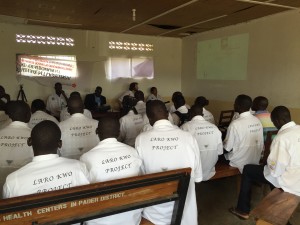Basic Humanity
August 29, 2016 • mhugo • No CommentsMichelle Hugo is a Global Engagement Fellow who spent the summer of 2016 working with a medical mission in Pader, Uganda.
Working with and for the Northern Uganda Medical Mission (NUMEM) and MGY has revealed some of the purest examples of humility. Those who work for these organizations show great humility (also just basic humanity) by traveling to teach, not because they know better, but as a partner to the community wherein they join to work towards better health services for people who have minimal access.
Our training started on a Tuesday and ended that Friday. For four days we traveled to a health clinic an hour away, often having to take two trips to fit everyone in. It was amazing to watch the learning curve of the VHTs in 4 days. In the beginning they didn’t know what vital signs were, let alone how to take them. By the end you could over hear VHTs making fun of each other using pulse and blood pressure as the punch lines. In the end they not only knew how to take vital signs, but what are the warning signs of dehydration, characteristics of infant diseases, how to control a hemorrhage, to assess an emergency situation, how to stabilize a patient in case of snake bite, and even forms of osteopathic medicine. The transformation was incredible and inspiring. Each of the 25 VHTs wanted to soak up every bit of information they could.

This training definitely made me realize the privilege we have in the “developed” world. Teaching anyone how to take temperature, let alone a medical worker, is unnecessary in most of the United States because everyone knows how to do that by the time they are 5 years old. Every household has a thermometer and everyone know how to take someone’s pulse. Yet, here, this is all completely new information! The VHTs are the frontline to healthcare in their villages and they don’t even go through a basic medical training. The government implemented this VHT program where every village or sub-district elects a Village Heath Team, and yet that is all that is required. An election. Then they are expected to be able to help and treat their community. It is unfair to them and to their community. Many complained that community members got easily irritated with them because of their lack of knowledge and medical resources. No wonder, the community members are told that they have medical professionals around them to take care of them, but these people are not equipped with the knowledge or materials to help.
MGY started doing these trainings in Peru, and when they heard of NUMEM, they decided to try implement a program here, in Pader, as well. I think they were surprised how much they were needed here. That with such a dense population (in comparison to where they work in Peru) they is such a lack of basic medical emergency knowledge. MGY raised enough money to provide the VHTs with more than information, but materials to help them provide better health services to their communities. Each VHT was given a stethoscope, thermometer, blood pressure cuff, latex gloves, gauze, paracetamol (a pain reliever), hydrogen peroxide, bandage tape, alcohol swabs, scissors, and oral rehydration salts. All these materials were put into their new weather proof bags to go along with their official VHT shirt. They were all quite chuffed that they now had actual VHT gear, none of it mandatory, but definitely embraced.

It’s also amazing to think that the training is not over. All of the videos and tutorials from the training are available on tablets that will be available to the VHTs to refresh their memories about what they learned during the training. These tablets will also be the basis for a new record system to keep track of patients. Additionally, Nalini and I traveled out to the VHT communities to informed the communities of their VHT’s new capabilities and also hear from the communities as to what they want the VHTs to be further trained in. Then 6 months from now the MGY team will return and do another training with more VHTs. And they will keep coming back every 6 months for an indefinite number of years, basically until the VHTs can sustain the trainings by training within the VHT program. Essentially, once VHTs train VHTs then MGY will turn its attention somewhere else. Their goal is a self-sustaining program. It will be incredible to see the change in community health over the next couple years in and around Pader.

